In today’s fast-paced Printing & Publishing KPI Dashboard in Excel industry, tracking performance is critical. Staying competitive means understanding your Key Performance Indicators (KPIs) and making data-driven decisions. Our Printing & Publishing KPI Dashboard in Excel is a powerful template designed specifically for this purpose, providing real-time insights into essential KPIs with user-friendly visuals and dynamic updates. This guide will walk you through all the features, advantages, best practices, and opportunities for improvement in utilizing this dashboard effectively.
Click to buy Printing & Publishing KPI Dashboard in Excel
Key Features of the Printing & Publishing KPI Dashboard
The Printing & Publishing KPI Dashboard offers a comprehensive overview with seven well-organized worksheets to streamline data input and tracking:
Home Sheet
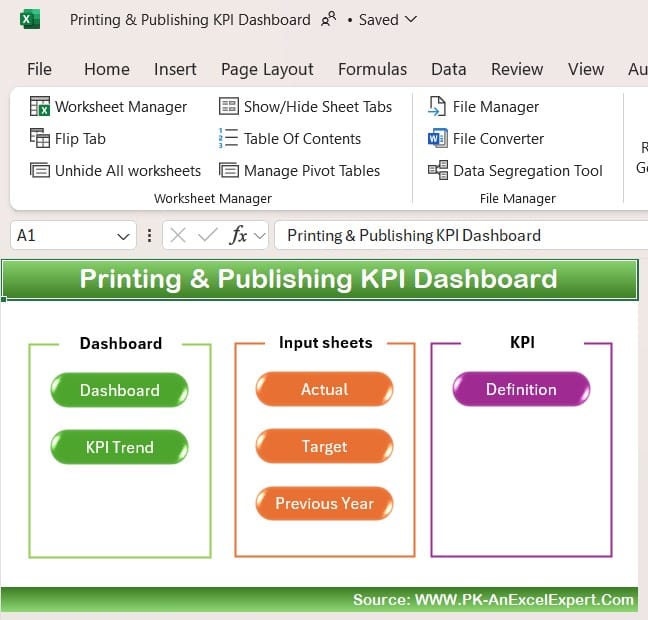
The Home Sheet is the starting point, serving as an index with six navigational buttons to jump directly to each section of the dashboard. This layout simplifies access and improves the user experience by making it easy to locate relevant sheets.
Click to buy Printing & Publishing KPI Dashboard in Excel
Dashboard Sheet Tab
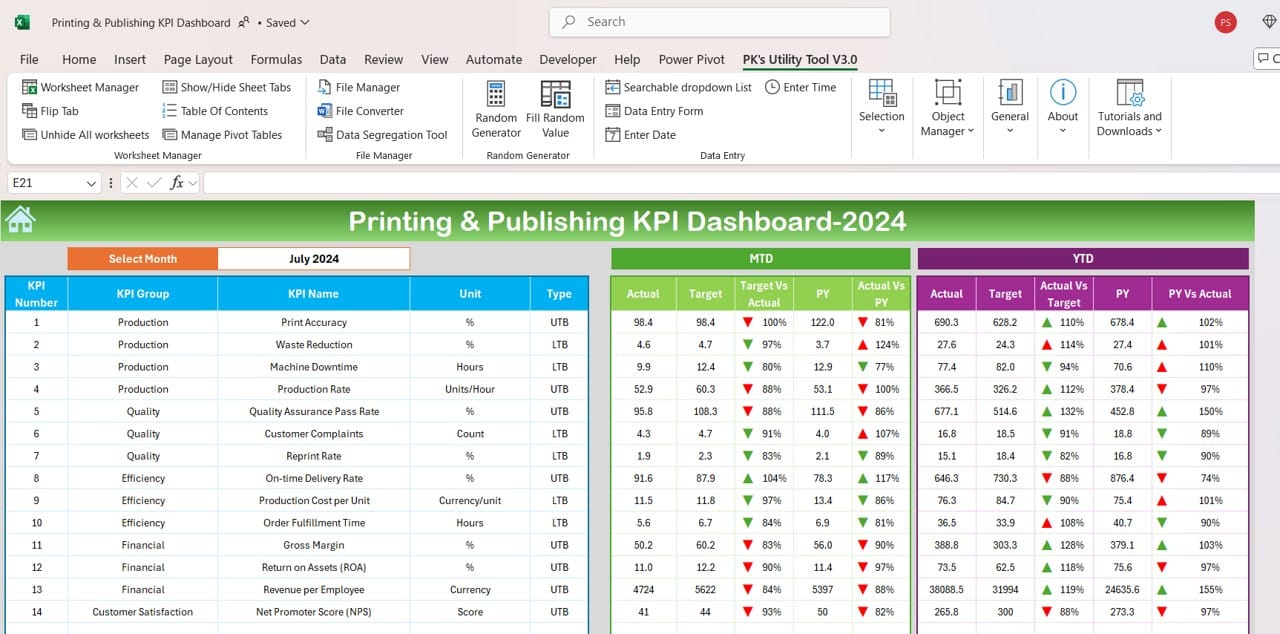
The Dashboard Sheet is the core of this template, providing a complete overview of your monthly and yearly data. You can select a specific month in cell D3, and the entire dashboard will update automatically to reflect the data for that month.
- MTD (Month-to-Date) Data: Displays Actual, Target, and Previous Year data, with visual indicators using conditional formatting to show if KPIs are improving or need attention.
- YTD (Year-to-Date) Data: Shows Actual, Target, and Previous Year numbers, with arrows indicating performance against the target and prior year.
KPI Trend Sheet Tab
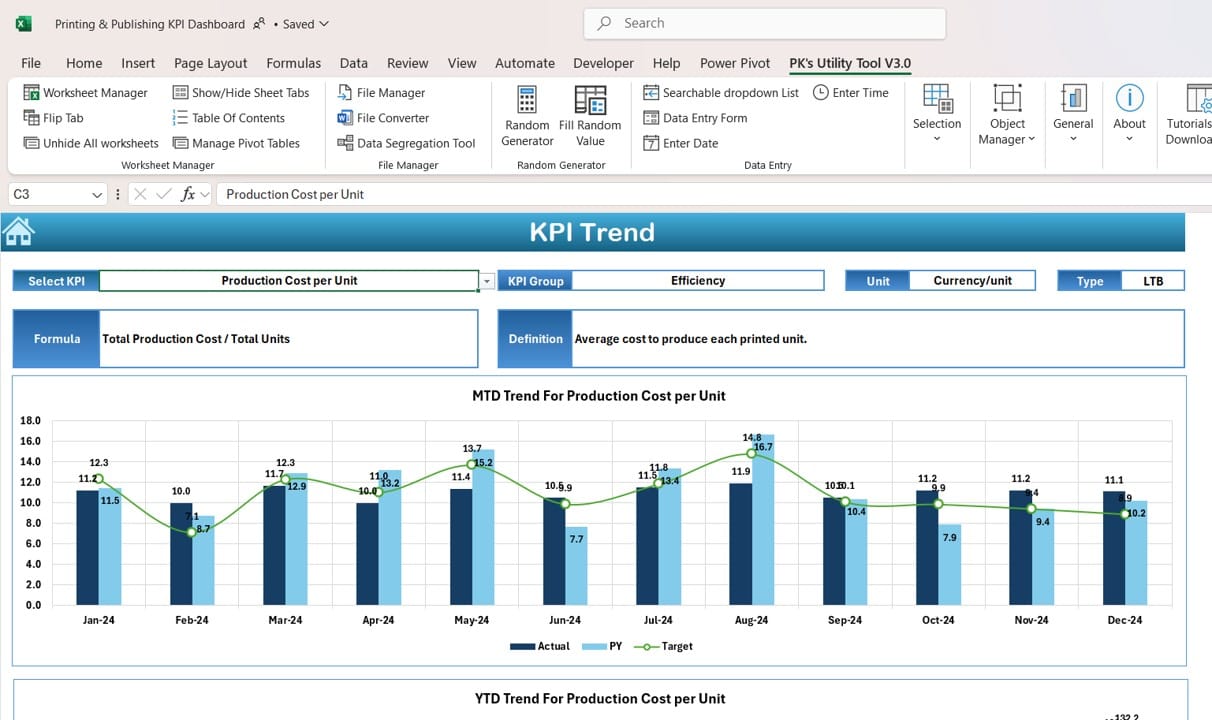
In this sheet, you can select a KPI from the dropdown in cell C3, which dynamically updates the display. This sheet presents:
- KPI Group
- Unit of KPI (e.g., percentage, quantity)
- Type of KPI (whether a higher or lower value is better)
- Formula and definition of each KPI
- Additionally, MTD and YTD trend charts for Actual, Target, and Previous Year values visually track performance.
Click to buy Printing & Publishing KPI Dashboard in Excel
Actual Numbers Input Sheet
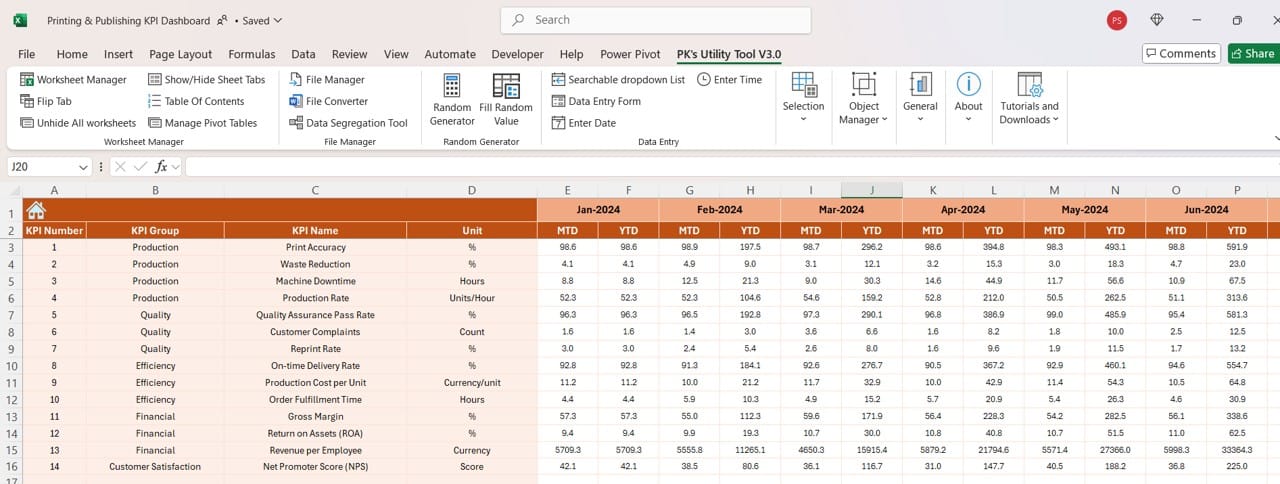
Enter actual performance figures here. You can set the first month of the year in cell E1, which ensures accurate data tracking for both MTD and YTD metrics across each KPI.
Target Sheet Tab
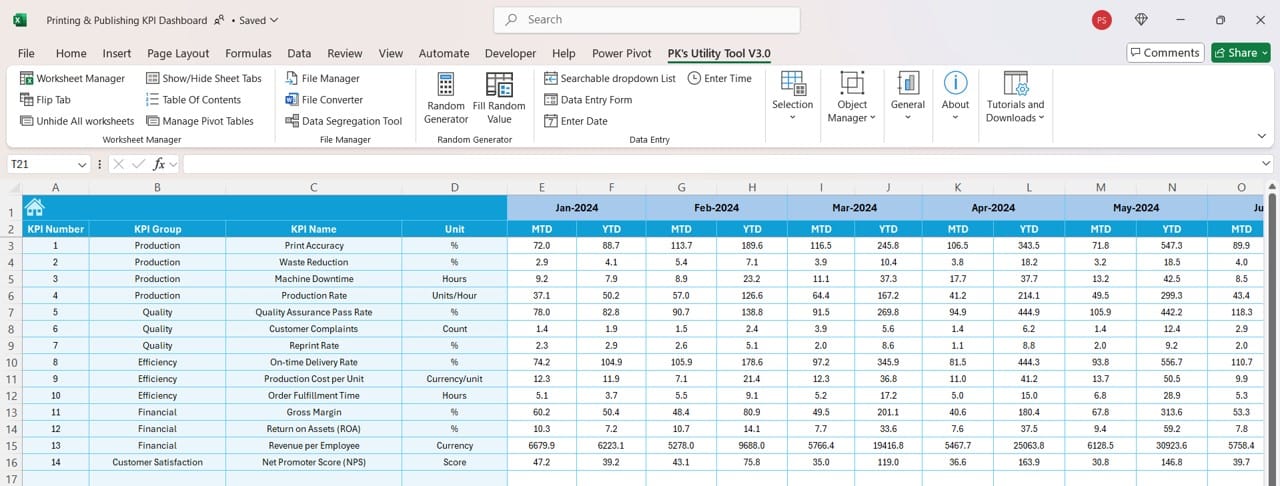
The Target Sheet is where you define monthly and yearly targets for each KPI, allowing the dashboard to compare Actual performance against these benchmarks.
Previous Year Number Sheet Tab
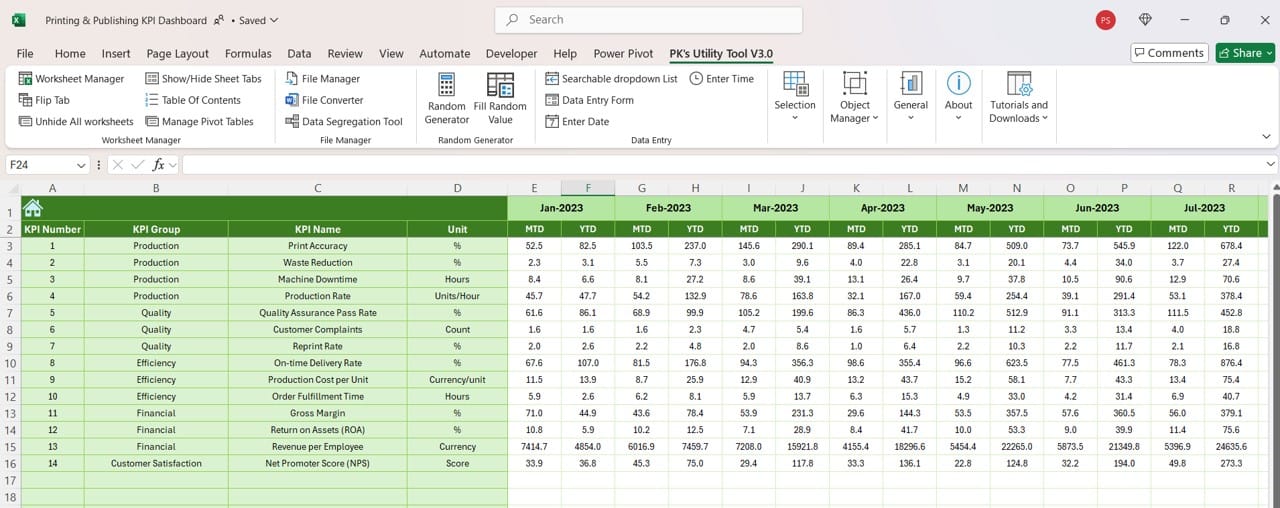
Input last year’s figures to enable year-over-year comparisons, helping you understand performance trends over time.
KPI Definition Sheet Tab
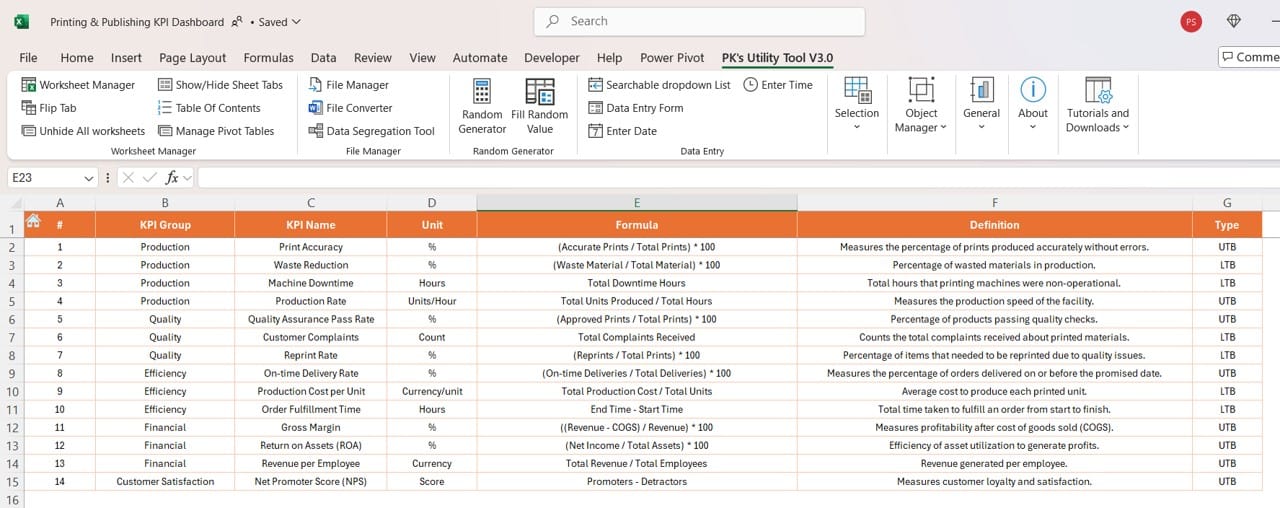
Here, you document each KPI’s essential details, including Name, Group, Unit, Formula, and a clear definition. This sheet serves as a reference, ensuring that each KPI is accurately understood and tracked.
Click to buy Printing & Publishing KPI Dashboard in Excel
Advantages of Using the Printing & Publishing KPI Dashboard
Utilizing this KPI dashboard offers several benefits that enhance productivity and decision-making:
- Real-Time Data Analysis: By selecting a month in the Dashboard Sheet, all related data is instantly updated, providing accurate insights into your current performance.
- Comprehensive KPI Tracking: With detailed MTD and YTD data for both current and previous years, the dashboard enables well-rounded performance tracking.
- User-Friendly Navigation: The Home Sheet simplifies navigation, ensuring users can quickly access each part of the dashboard without confusion.
- Dynamic Visuals for Better Insights: Conditional formatting and trend charts make it easy to spot patterns and trends, allowing for proactive management and strategic adjustments.
Best Practices for Using the Printing & Publishing KPI Dashboard
To maximize the value of this dashboard, follow these best practices:
- Regularly Update Actual Numbers: Ensure that you input the actual figures consistently to maintain the dashboard’s accuracy and relevance. Regular updates enable more reliable trend analysis.
- Set Realistic Targets: Define targets that are achievable yet challenging, helping you stay motivated and continuously improve.
- Analyze Trends Regularly: Utilize the KPI Trend Sheet to monitor long-term trends. Understanding these trends is crucial for identifying areas that need strategic adjustments.
- Leverage Year-Over-Year Data: Comparing current data with last year’s numbers provides a broader perspective on performance, helping you measure growth and identify potential areas for improvement.
Click to buy Printing & Publishing KPI Dashboard in Excel
Opportunities for Improvement in the Printing & Publishing KPI Dashboard
No system is perfect, and there are always opportunities to refine and optimize how you use the Printing & Publishing KPI Dashboard. Consider the following areas:
- Automate Data Entry: While the template simplifies data management, manual entry can be time-consuming. Automating data input by integrating with other systems or data sources can save time and reduce the risk of errors.
- Enhance Customization Options: Depending on your organization’s unique needs, you may want to add customization options such as additional KPIs or personalized metrics. This can help you gain insights tailored specifically to your company’s goals.
- Improve Visual Indicators: Adding more visual indicators or alerts for KPIs that fall below a certain threshold could enhance the dashboard’s usability. For instance, a color-coded system can help you quickly identify areas that need immediate attention.
How to Make the Most of Your KPI Dashboard in Excel
The Printing & Publishing KPI Dashboard is packed with valuable features, but its effectiveness depends on how well you utilize its capabilities. Here are some actionable tips:
- Prioritize Key Metrics: Identify the KPIs most crucial to your organization and focus on those to drive meaningful change.
- Engage Your Team: Share the dashboard with team members to encourage accountability and collaboration. Discuss performance regularly to make data-informed decisions.
- Adapt KPIs Over Time: Business goals evolve, and so should your KPIs. Periodically review and update the KPIs to ensure they align with current priorities.
Frequently Asked Questions about the Printing & Publishing KPI Dashboard
Q. What is the purpose of a KPI Dashboard in printing and publishing?
A KPI dashboard centralizes your critical performance indicators, providing quick insights into essential metrics. It helps you monitor productivity, efficiency, and progress toward goals, making it easier to make informed decisions.
Q. How often should I update the KPI Dashboard?
To maintain accuracy, update your actual performance numbers regularly, ideally monthly. This ensures that the MTD and YTD data reflect real-time performance.
Q. Can I customize this dashboard to include additional KPIs?
Yes, the dashboard is customizable! You can add new KPIs or modify existing ones based on your business needs. Just ensure that all changes are reflected across the relevant sheets to maintain functionality.
Click to buy Printing & Publishing KPI Dashboard in Excel
Q. What if I want to automate data entry in the dashboard?
Automating data input can be achieved by integrating your Excel dashboard with other data sources. Consider tools that link data between systems to reduce manual entry and enhance accuracy.
Q. How can I use this dashboard to improve performance?
Use the visual indicators and trend charts to identify areas where performance lags and where growth opportunities exist. Set realistic targets, review trends, and make data-driven decisions to continuously improve your outcomes.
Q. Are there other templates for different industries?
Yes, Excel KPI dashboards are available for various industries, each tailored to specific KPIs relevant to their field. For example, publishing KPIs may differ from those used in manufacturing or retail.
This structure will make the article informative, easy to navigate, and rich in SEO-relevant content that helps readers understand and apply the Printing & Publishing KPI Dashboard effectively in their work. If you’d like to add any specific details or examples, just let me know!
Visit our YouTube channel to learn step-by-step video tutorials
View this post on Instagram
Click to buy Printing & Publishing KPI Dashboard in Excel



